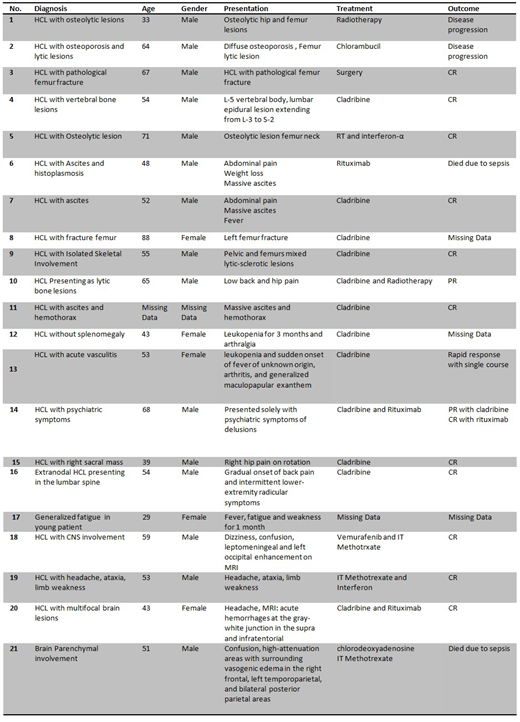Hairy cell leukemia (HCL) is a distinctchronic lymphoproliferative disorder that accounts for 2% of all adult leukemias. The median age at the time of diagnosis is 52 years with a male to female ratio of 4:1.
Hairy cell leukemia predominantlycharacterized by infiltration of peripheral blood, bone marrow, and spleen by malignant cells with prominent irregular cytoplasmic projections, namely, "hairy cells". HCL patients may be asymptomatic or develop symptoms of cytopenia, particularly infections .
The exact prevalence of atypical presentation of HCL is difficult to be determined because most cases were published as incidental reports.
The classical presentation of Hairy cell leukaemia includes splenomegaly (80-90%), pancytopenia (60-80%) and hepatomegaly (40-50%), however, the same may not be true in the clinical settings.
As hairy cell leukemia may present with a wide range of atypical organ involvements which could result in a diagnostic dilemma.
The aim of this literature review is to highlight non- classical presentations of HCL and the importance to have high index of suspicion to consider a diagnosis of HCL based on histomorphological features even in the absence of classical clinical features.
Method:
We searched the medline database (PubMed), GoogleScholar from1985 until 2018 with the following search terms: atypical presentation of hairy cell leukemia ,unusual cases of hairy cell leukemia,unique hairy cell leukemia presentation.
Result:
A total of 21 cases were found, with age range from (29-88),5 cases were female and the rest were males.
Skeletal involvement was the most common presentation with osteolytic bone lesion.
Majority of the patients were treated with Cladribine,13/21 showed complete remission.
Discussion:
HCL is an indolent disorder of B-cell origin that accounts for 2% of all forms of leukemia and 8% of lymphoproliferative diseases.
In our literature review we looked up the unique presentations, which
Most of the reported cases we found involved the skeleton in the form of pathological fracture and osteolytic lesion.
Serositis, in the form of massive ascites and pleural effusion has been reported. Additionally, Cases of central nervous system involvement and presentation at young age were observed.
Due to rarity of the disease and no established treatment modality for unusual organ involvement, standard treatment with Cladribine result in complete remission in 61% of the observed cases.
Conclusion:
While Classical presentation of hairy cell leukemia is well described in the literature.
atypical presentation is still rare but with diverse presentation.
most of the cases reviewed in the literature were middle age males, majority had good response to treatment, while the rest had disease progression .
rare pretension of Hairy cell leukemia despite being rare should always be considered ,particularly in cases of pathological fractures or unexplained serositis.
No relevant conflicts of interest to declare.
Author notes
Asterisk with author names denotes non-ASH members.


This feature is available to Subscribers Only
Sign In or Create an Account Close Modal